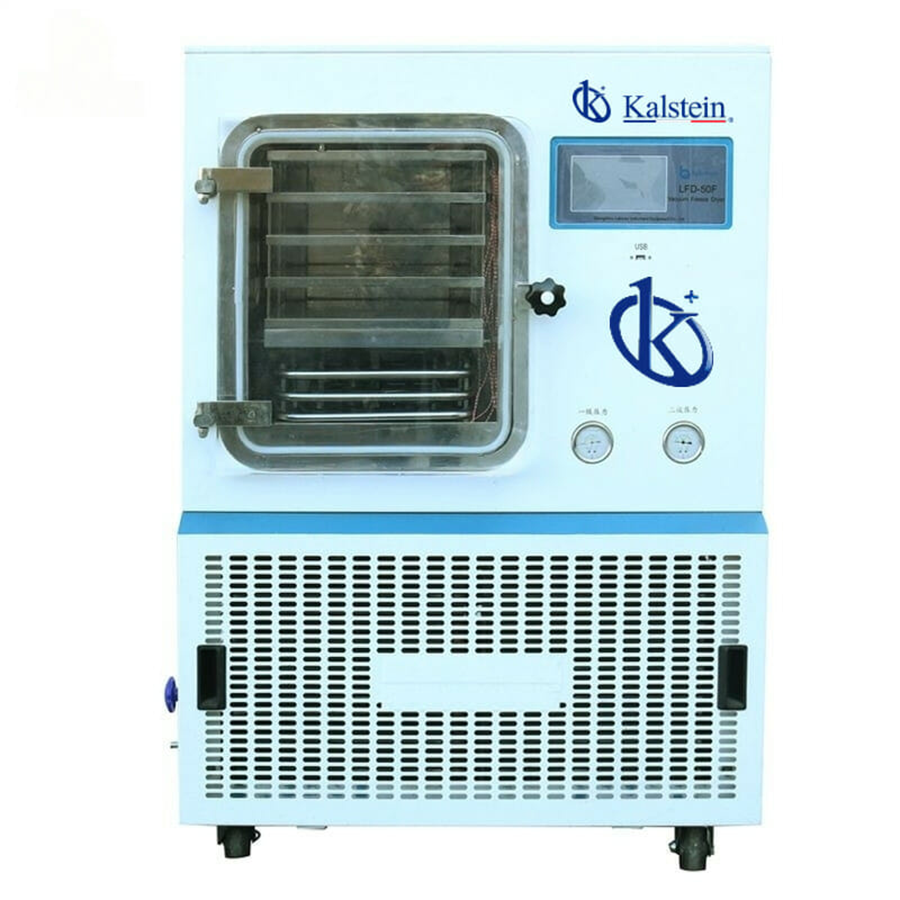The freeze-drying of food is a preservation process that involves three stages: freezing, sublimation, and desorption. Firstly, the food is frozen at very low temperatures, turning its water content into ice. The pressure is then reduced, and gentle heat is applied, allowing the ice to sublimate; that is to pass directly from ice to vapor, without going through the liquid phase. Finally, in the desorption stage, residual water is removed. The result is a dry, lightweight food that retains its nutrients and can be easily rehydrated by adding water.
Freeze-drying equipment is essential in the research sector and the food industry since it allows the preservation and analysis of various samples. On this occasion, we will focus on two models from the Kalstein brand: YR05985-1 and YR05985-2, which stand out for their performance and efficiency.
Processing Area and Freeze-Drying Trays Analysis
The modern laboratory requires cutting-edge equipment to optimize processes and achieve high-quality results. The YR05985-1 and YR05985-2 food freeze-dryer models by the renowned Kalstein brand ensure exceptional accuracy and efficiency in freeze-drying. Designed with a freeze-drying area of 0.7m2 and 1.04m2 respectively, these machines provide the optimal space to freeze-dry a wide range of food samples. https://kalstein.pl/product/silicone-oil-heating-lyophilizer-yr05985-1-yr05985-2/
In terms of processing capacity, the YR05985-1 model comes with four material trays, while the YR05985-2 model has six material trays. Both models have the same material plate size of 475 × 355 mm, offering enough space to accommodate enough samples required by researchers.
Temperature and Shelf Space Differences Detection
The YR05985-1 and YR05985-2 models are equipped with a shelf temperature range from -55°C to +70°C. This wide range of temperatures allows users to freeze-dry a variety of foods, from those that require lower temperatures to those that need higher temperatures. The freeze-dryers maintain a shelf temperature difference of ±1 °C when balanced, ensuring consistency throughout the process.
Moreover, the space between the shelves is a critical consideration in the design of these freeze-dryers. The YR05985-1 model has a space of 50 mm between shelves, while the YR05985-2 model offers a larger space of 70 mm. This extra space is useful to accommodate larger foods or a greater number of samples simultaneously.
Cold Trap Technology and Water Capture Capacity
An innovative feature of the YR05985-1 and YR05985-2 models is the cold trap technology. Both models have a cold trap temperature of ≤ -75 °C, even when unloaded. This feature is vital to prevent the condensation of water vapor in the vacuum chamber, thus ensuring an unparalleled freeze-drying efficacy.
Additionally, these freeze-dryers have an impressive water capture capacity, which is larger in the YR05985-2 model that can collect up to 15 kg of water in 24 hours, compared to the 10 kg that the YR05985-1 can collect. This is essential for those laboratories that process large volumes of samples, as it significantly reduces the freeze-drying time.
Energy Consumption Efficiency and Pumping Power
Finally, these models have a pumping rate of 8L/S and 15L/S respectively, and a definitive vacuum of ≤5pa, even when unloaded. This pumping capacity guarantees a faster and more efficient freeze-drying process.
Both models require a power of 5500w and 6500w, respectively. Despite their high power, Kalstein’s freeze-dryers are notable for their energy efficiency, which means they are an excellent investment for any laboratory seeking to maximize productivity while minimizing operational costs.
In summary, the YR05985-1 and YR05985-2 food freeze-dryer models from Kalstein offer cutting-edge technology with impressive operational efficiency and precision in freeze-drying.

